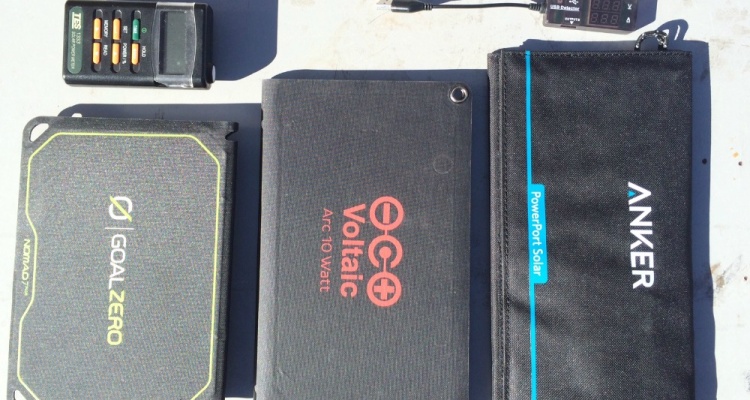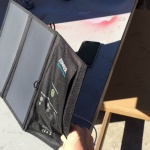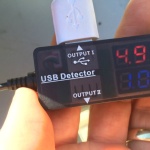Direct solar charging from a solar panel without any intermediate battery reduces complexity and weight of the system, but there are several challenges to making it work consistently across all phones.
We tested the direct charging performance of our Arc 10W alongside the Goal Zero Nomad 7 and Anker PowerPort 15W and are sharing the results here.
Direct Solar Charging Problem 1: Auto Reset
Almost every phone has a minimum amount of input power required for it to charge. This presents a large problem for solar panels when a cloud passes over the sun or a passer-by walks in front of the panel, since the power output may temporarily drop below the minimum required by your device. In some cases, the phone will not resume charging even when the sun is bright again, and the phone might display some warning such as “This charger is not compatible with your device”.Traditionally the solution is to unplug and replug the charging cable to reset the phone’s charging circuit, but an Auto Reset function works around this problem electronically by shutting off the circuit and restoring power.
It decides when to do this by measuring the difference in power between what the panel can produce in that moment compared to how much power the phone is actually taking. If this power differential is designed to be too small, the circuit will frequently reset even when it does not need to, resulting in a constantly buzzing phone. On the other hand, if the power differential is designed to be too large, the circuit will not reset even when you would want it to, and your phone will continue in its non-charging state.
Direct Solar Charging Problem 2: Slow Charging
Sometimes on cloudy days, the solar panels will produce slightly less power than normal and the phone will charge at a slower rate than it normally does, but no quite slow enough to activate the auto reset circuit. The phone will appear to be charging as normal, but in reality it is locked in a slow charging state that does not reset even when the sun emerges again.
We have seen instances with an iPhone 5s where it will appear to be charging, when really it is only taking 1/10th of it’s normal charge rate. The user will see the lightning bolt on their phone’s battery display, but the phone’s battery might actually drop in power. Android phones can experience this problem as well, it is not limited to Apple products.
In these situations, the solar panel circuit should be smart enough to reset when the phone is not taking enough power.
Direct Solar Charging Problem 3: Best Pin Configuration for Every Phone
The USB charger and charging cable that come with your phone will have a specific voltages on the positive, negative and data pins. Your phone charges fastest when it sees those voltages (and the current to back it up) and may charge at a slower rate if it sees something different. Therefore, it is a challenge to design a USB port that successfully charges every device at their fastest rate.
Qualcomm 2.0 and 3.0 protocols are designed to solve this problem, but we haven’t seen it successfully integrated into a direct charging application yet.
Charge Rates in Good Conditions
Watts Into Device
Voltaic Arc 10WAnker PowerPort 15WGoal Zero Nomad 7
| iPhone 5S | 4.9 | 4.9 | 3.6 |
| iPhone 6S | 3.5 | 3.2 | 2.3 |
| Samsung Galaxy S5 | 5.8 | 7.8 | 3.4 |
| HTC One M8 | 4.9 | 4.6 | 3.5 |
| LG G4 | 5.4 | 5.9 | 3.0 |
The Voltaic Arc 10W and Anker 15W folders performed comparably (with the exception of the Galaxy S5) even though the Anker is rated to have 5 more Watts. The Goal Zero Nomad 7 was noticeably slower for every device we tested (including some not shown), which is understandable considering it is rated for less power than either folder.
Recovery from Heavy Shading and Clouds
Direct solar charging recovery behavior varied by phone:
iPhone 5S & iPhone 6S: Reset doesn’t happen below 300mA on Arc 10W. It appears to lock at around 400mA after clouds pass and not recover fully to 1A charging. The Anker 15W requires the power to go below 200mA for it to reset and locks at around 500mA after cloud re-appears. With the Nomad 7, the iPhone 5 seems to lock in at 100mA and doesn’t recover to fast charging mode.
Galaxy S5: Performed well with all chargers. When the sun re-appears, the power floats up to take in as much as possible.
HTC One M8: Didn’t activate reset on any of the chargers we tested. After the sun re-appears, it continues to charge at only 250mA.
LG G4: Restored to full charging rate when sun re-appears on Arc 10W, locked in at a low 250mA charging rate on the Anker and Goal Zero.
Important Details on Chargers
For us the construction of the charger, particularly the quality of the coating and lamination, is very important. Those materials determine how long the product will last in the sun which is hopefully where your charger will be.
| Voltaic Arc 10W | Anker PowerPort 15W | Goal Zero Nomad 7 | |
| Weight (Ounce) | 10.6 | 13.2 | 12.8 |
| Dimensions (Inches) | 10.25 x 13 | 11 x 18 | 8.75 x 13 |
| Coating | ETFE | PET* | PET* |
| Rated Power (Watts) | 10 | 15 | 7 |
* Neither manufacturer shared their coating, but the coating had the appearance of PET which is non UV-resistant
Workarounds
There are two potential workarounds if direct charging isn’t working well on your phone.
Option 1: Add a battery pack between the charger and your phone. Some power is wasted in chemical energy going from battery to battery, but is typically made up by absorbing every bit of solar power possible into the battery. Unlike many phones, our batteries are specifically designed to take as much or as little power as the panels can provide, even as low as 50mA.
Option 2: In less than ideal conditions, monitor your phone and unplug and replug the USB cable every once in a while to manually reset the system to get the fastest charging rate.
Test Equipment
To measure power flow, we used a DROK USB multimeter. It is not as accurate as some other systems, but it is very portable and consistent and we used the same testing device across all products. We tested all devices on a bright, sunny day without any clouds in the sky, and pointed each folder at the sun for maximum power generation.







Hello. I am volunteering in Elephant conservation programme in Zambia where I will be placed in three jungle camps that only have solar. I need to charge my iPhone 12, ipad, camera and maybe iMac computer. What do you recommend?
Hello. I am going to be volunteering in conservation in three jungle camps in Zambia. They rely solely on solar and we are advised to take solar battery packs. I will be charging my iPhone12, ipad, camera and maybe iMac computer. What do you recommend and do you discount volunteers?
Hi,
My name is Morgan Roberts and I am about to embark on a 27 month adventure with Peace Corps in Vanuatu. I am reaching out because we have been told numerous companies partake in donations for Peace Corps Volunteers and I was wondering if Voltaic participates.
Though I will be teaching English and training teachers in the South Pacific, my background is in film and journalism and I would love to bring photography into the classroom. There is a phenomenal program called SMART, which teaches young girls leadership skills and empowerment through understanding technology, but my goal is to take this a step further through the lens.
This calls for using my personal equipment in a very humid island, which is naturally surrounded by water and thrives off of solar power. Anything is very much appreciated since I will have very little access to things outside my village. Please let me know if you need anything, I’ll happily provide it.
Thank you so much for your time,
Morgan Roberts
Hi Morgan – we work with a lot of Peace Corps Volunteers and have a special discount program, see: https://blog.voltaicsystems.com/voltaic-hearts-peace-corps/ – If you send your Peace Corps acceptance letter to sales@voltaicsystems.com, we will provide you with the discount code.
I am going back woods in WVa. Very ruff country. I n Jan What system do you recommend to charge iPhone 7
Hi Eddie,
The Arc 10W Kit is a great mix of power and weight – https://www.voltaicsystems.com/arc10w-kit
Hello,
I have a friend who is insulin dependant. With recent power outages due to natural disasters I worry about her insulin getting ruined by heat. Would your product allow for storage of energy to run a small fridge?
Not a typical refrigerator. You would need a refrigerator that is designed to be powered by DC and is very small. I would suggest searching for “DC Powered Cooler” – we have not run compatibility tests, but you would probably need a fairly good sized system to power them.